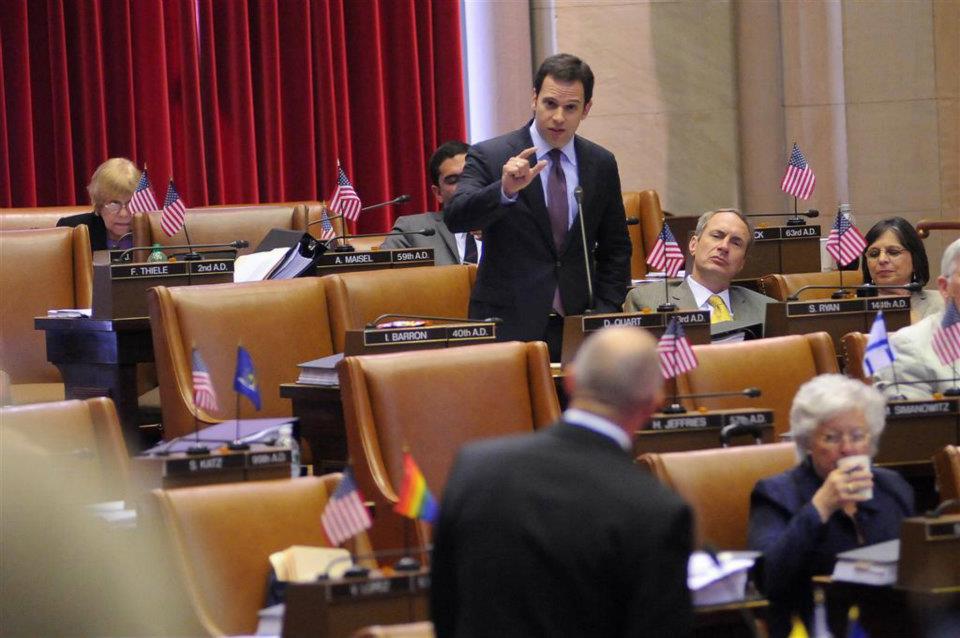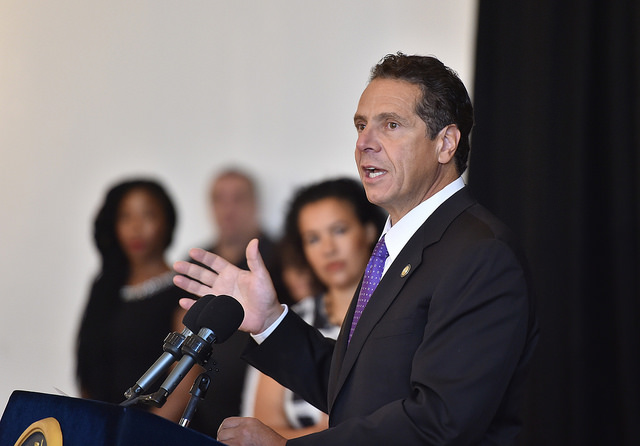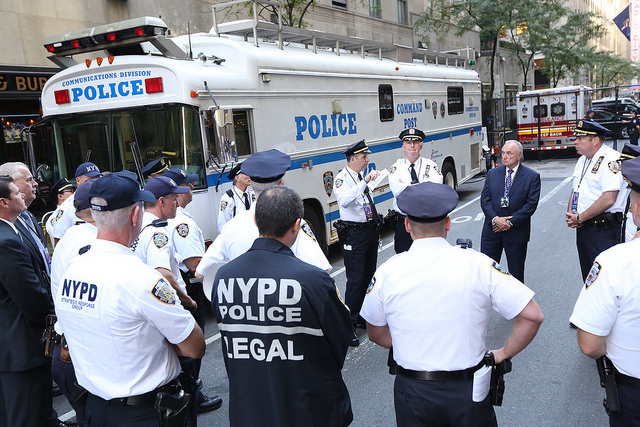A Better Way to Fund the MTA

Assembly Member Quart, the author (photo via Facebook)
No New Yorker has been able to miss the recent back-and-forth over MTA funding. Once again, we are trapped in an unwinnable argument. Whose responsibility is the MTA capital plan? Should New York City contribute more funding? Or is it the state's responsibility, since the MTA is a subsidiary of state government?
The conversation has devolved into threats against the New York City transit system and, as of yet, yielded no real solutions. In fact, this debate is exactly the problem. It completely misses the point.
We're funding the MTA Capital Program all wrong.
Nationally, New York City's transit system is unique. It is what allows us to be a city that functions with aberrantly low levels of car ownership. We are 'the city that never sleeps' because of our round-the-clock transit system. Without it, the gears of our city simply won't turn. And without the economic activity that is driven by transit in New York City, the rest of the state suffers as well. The entire state is dependent on a strong city transit system.
Framing the capital funding process as a question of city dollars versus state dollars is just obfuscation. The critical truth about all of these dollars is that they're not guaranteed. The MTA Capital Program, which pays for upkeep and expansion of our transit system cannot count on a single dollar of funding from dedicated budgetary revenue streams.
This means that every five years, we go through through the same argument we are having this year - quibbling over who will pay for the capital plan while our transit infrastructure deteriorates. Our subways and buses are more crowded, less punctual, and far more likely to break down than they were just a few years ago.
Without significantly more funding, these problems will only get worse.
There's an alternative, though, and it's one that we've already seen work. Across the ledger, the MTA operating budget benefits from a number of dedicated revenue streams, including the mortgage recording tax and the commuter tax. These funds are statutorily required to be used for their stated purposes.
We must expanding this idea to the capital side. In order for New York City to continue being a city that drives the state's economy, we need to ensure the upkeep of our transit system, but we also need to continue expanding it, to make sure that every part of the city that never sleeps is equally able to access transit.
It's time to put a stop to the budget dance. It's time to stop enabling unproductive arguments that distract from the real issues. It's long past time for the MTA capital program to be supported with statutory, dedicated, un-sweepable revenue streams that will allow maintenance and improvement of our subways and buses, the critical infrastructure that keeps New York City moving and drives the New York State economy.
***
Dan Quart is a New York State Assembly member representing the East Side of Manhattan. He is on Twitter @DanQuartNY.
***
Have an op-ed idea or submission for Gotham Gazette? E-mail editor Ben Max: This email address is being protected from spambots. You need JavaScript enabled to view it.
Shooting Deaths Recall New York's Long History of Trying to Curb Gun Violence

Gov. Cuomo (photo: Office of the Governor - Kevin P. Coughlin)
New York has been shocked by gun violence for a long time.
Recently, on September 7, Carey Gabay, former assistant counsel to Governor Cuomo and a deputy counsel at the Empire State Development office in New York City, was shot in the head near the site where the West Indian American Day Carnival parade was scheduled to kick off a few hours later. He died of his wounds on September 16.
"We must act and we must say we're not going to take it anymore," Governor Cuomo said at Gabay's funeral service. "The killing has to stop."
Since the shooting, Cuomo has called attention to the Secure Ammunition and Firearms Enforcement (SAFE) Act that he pushed through the legislature early in 2013, in the wake of the Sandy Hook Elementary School shootings in Connecticut. Gun rights activists continue to fight that law. Cuomo consistently declares it a national pacesetter and insists that federal action is needed.
Cuomo repeated his appeal after the October 1 killing of nine people by a gunman at a community college in Oregon. Calling gun violence "a sickness that continues to claim innocent lives and threaten our communities" while "our elected officials in Washington continue to sit on their hands." Guns continue to flow into New York from states with laxer gun laws, the governor added.
Today, New Yorkers continue to argue over the SAFE Act and the gun violence that plagues major cities, while state gun-permitting laws are complicated. New York's gun policies began over a century ago.
On August 9, 1910, New York City Mayor William J. Gaynor, who had taken office in January, was waiting to board the ship SS Kaiser Wilhelm der Grosse at the terminal in Hoboken for a trip to Europe when he was approached by James J. Gallagher, who had been discharged from his position as a New York City dock night watchman earlier in the year for dereliction of duty. Repeated letters to the Mayor appealing for reinstatement got no results.
Gallagher walked up to the mayor and shot him in the neck. Sanitation commissioner William Edwards, who had been there to see the mayor off, was also wounded. Gaynor's aides and bystanders wrestled the would-be assassin to the ground. A New York World photographer happened to be on the dock for what he had assumed would be a routine photo of the mayor. Instead, he snapped a picture an instance after the shot, capturing a bloodied Gaynor reeling from the shot. The photo was soon on the front pages of city newspapers and was widely reprinted. It was a graphic representation of the horror of completely unexpected gun violence.
Gaynor survived but the bullet lodged in his neck and could not be removed. He recovered slowly. It caused him pain and discomfort until his death in 1913.
"I shot him because he robbed me of my position," Gallagher told police who arrested him. "He could have put me back to work and he wouldn't."
At his arraignment, the prosecutor asked Gallagher if he had read about the assassination of other public men. He replied he had read about the assassination of President William McKinley in 1901. "Do you believe in it?" asked the prosecutor. Gallagher's chilling reply was: "Yes, if you have a grievance and can't right it any other way."
Apparently because of the mayor's slow recovery, Gallagher was not tried for shooting him but was sentenced to 12 years for shooting Commissioner Edwards. He died in prison in 1913.
David Graham Phillips was a prominent novelist living in New York City in the early 20th century. Phillips' novels often commented on social issues of the day and frequently chronicled events based on his real-life experiences as a journalist before he took up writing fiction. He wrote a series of articles entitled "The Treason of the Senate" in Cosmopolitan in 1906 that exposed corruption in the Senate. Phillips was something of a public figure, often seen strolling on New York sidewalks.
On January 23, 1911, Fitzhugh Coyle Goldsborough, an eccentric violinist and music teacher, gunned Phillips down outside the Princeton Club on the north side of Gramercy Park. Club members heard the assailant cry out "I've been waiting for six months to get you" and then "Here you go!" as he shot the novelist six times. He then muttered "Here I go!" before shooting and killing himself. Phillips succumbed to his wounds the next day.
Police searched Goldsborough's apartment; from diaries and papers they learned he had become fascinated with one of Phillips' novels, "The Fashionable Adventures of Joshua Craig." He believed it drew on Goldsborough family history and portrayed it in an unflattering way, and that the novelist had modeled the central character on Goldsborough's sister. He also believed Phillips could read his mind.
The shootings of Mayor Gaynor and David Graham Phillips provoked public outrage. But it was a rising tide of street gun violence that led to legislative action.
Timothy Sullivan, a Democratic state senator from the Bowery area of Manhattan, was appalled at the Gaynor and Phillips shootings. But he was even more alarmed about a rising tide of gang-related shootings in his district.
Sullivan, often known by his nickname "Big Tim," was unlikely to be mistaken for a do-good reformer. He was a Tammany Hall regular who was involved with gambling, prostitution, and corruption. But he was also concerned with the welfare of his constituents and Tammany Hall itself was becoming more reform-minded. In 1911, Robert F. Wagner was Speaker of the Senate and Alfred E. Smith was majority leader in the Assembly. They were both Tammany men but favored progressive policies.
Sullivan introduced a bill in the 1911 legislature to require licenses for New Yorkers to possess firearms small enough to be concealed. Possession of such firearms without a license was defined as a misdemeanor, and carrying one was defined as a felony.
Sullivan explained that "gun toters" (as the press often called gunmen) fell into three categories. The first was professional criminals. The second consisted of people who are deranged or commit gun violence in fits of rage. His law would help in those areas, he said.
But, Sullivan was more concerned with a third category, "...young fellows who carry guns around in their pockets all the time not because they are murderers or criminals but because the other fellows do it and they want to be able to protect themselves....those boys aren't all bad but they're in a mighty bad way. Just carrying their guns around makes 'em itch to use 'em."
The bill was opposed by some gun owners and gun manufacturers. One upstate senator told Sullivan that "your bill won't stop murders. You can't force a burglar to get a license to use a gun." Others warned that people would get guns from other states. But the bill found wide support among concerned New Yorkers in both parties who had been shocked by the assassination of a renown novelist and the assault on their city's chief executive.
Republican District Attorney (later Governor) Charles Whitman said that "carrying a weapon is an invitation to a crime. Reduce the weapons carried and you will reduce crimes of violence. There isn't any debating that point."
The Sullivan Act passed easily. It was challenged in court and debated for more than a century, but its basic provisions are still in place.
Gunfire that is completely unexpected is a frightening specter. Shortly before the shooting, a constituent had warned Mayor Gaynor against going around the city unescorted. "I do not think anyone would do me harm unless he was a lunatic," he responded, "and it is hard to guard against lunatics."
"I'm governor of New York and there's nothing I can say and there's nothing I can do," Governor Cuomo said, after visiting Carey Gabay at Kings County Hospital Center before he died. "Sometimes, it just hurts."
Yet the murder of the governor's aide and the killings in Oregon are certain to provoke more debate over gun violence in New York and elsewhere, and what can be done to curb it.
***
Dr. Bruce W. Dearstyne is the author of the book The Spirit of New York: Defining Events in the Empire State's History, published in 2015 by SUNY Press.
***
Have an op-ed idea or submission for Gotham Gazette? E-mail editor Ben Max: This email address is being protected from spambots. You need JavaScript enabled to view it.
Next Steps After Eye-Opening NYPD Inspector General Use-of-Force Report

(photo via NYPD on flickr)
Officer James Frascatore is working behind a desk after assaulting James Blake last month. But if history is a guide, there's far too strong a likelihood that he won't be held accountable for his action.
That's the key finding of the report released yesterday on use-of-force by the NYPD Inspector General: From 2010 to 2014, the NYPD failed to impose discipline in 35.6 percent of cases with substantiated evidence of excessive force. If we are honest, we know that this problem pre-dates Commissioner Bratton and this Administration, but we must rightfully look toward the Commissioner and the Mayor to take corrective action.
The 62-page report digs deeply into NYPD use of force, with a strong set of recommendations for how to fix the problems identified.
We are pleased to see Commissioner Bratton quickly adopt a number of the policy recommendations in the report, including a far more rigorous tracking system for use-of-force incidents, clearer definitions of use of force, better training, and an annual use-of-force report.
These are necessary and important steps in the ongoing effort to improve police-community relations. They must help officers better understand essential procedures and eliminate instances of excessive force like those that resulted in Eric Garner's death and James Blake's assault.
The key remaining issue, though, is accountability when excessive force is used. The NYPD Inspector General's report identifies this as a clear area of concern, and calls for specific and appropriate reforms.
Commissioner Bratton has indicated that he is creating an internal unit to monitor officers with frequent complaints against them and he has voiced his commitment to work more closely with the CCRB on its disciplinary recommendations.
At the same time, however, there is still no explicit acknowledgement of the reality that the IG's report demonstrates clearly: in far too many cases, NYPD officers have faced no accountability for excessive use of force. The real proof of effective reforms will be seen when there are fewer officers inappropriately using force and when officers who use excessive force are held accountable for their actions.
That is why establishing by law an NYPD Early Intervention System for overly-aggressive police officers, as proposed by Council Members Williams and Garodnick, is so important. By establishing a system to quantify excessive force complaints, our city can better understand which officers may be prone to excessive force and who may need additional training, supervision, or other consequences.
We look forward to working with Commissioner Bratton to codify by law the early intervention work he is doing, to consider other legislation before the City Council, including the Right to Know Act, and to adopt the remaining recommendations in the Inspector General's report. While the issues at hand are decades old, span many police commissioners, and are not confined to New York City, there is real opportunity for us to lead the way, and to do so now.
This report - data-driven, thoughtful, and constructive - demonstrates the value of the Office of the NYPD Inspector General, just as we hoped when we passed the Community Safety Act in 2013. In a short time and to the contradiction of critics, the NYPD IG has already made real contributions toward improving public safety and advancing civil rights.
***
Jumaane D. Williams and Brad Lander are New York City Council Members from Brooklyn who co-sponsored Local Law 70 of 2013, which established the Office of the NYPD Inspector General.
***
Have an op-ed idea or submission for Gotham Gazette? E-mail editor Ben Max: This email address is being protected from spambots. You need JavaScript enabled to view it.




